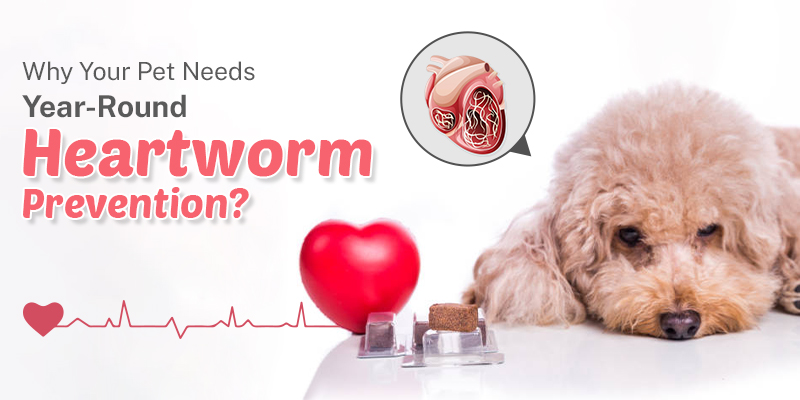Why Your Pet Needs Year-Round Heartworm Prevention?

Heartworm is not something that most pet parents think about every day, but it’s one of the biggest health threats that our furry companions face. Mosquitoes spread the parasite, and it does not take much to transmit. A single bite is enough. What starts out being invisible can turn into a serious condition that damages the heart and lungs before the pet parent can even spot early signs!
Now, the problem is that mosquitoes don’t follow rules. They invite themselves indoors and hang around with us to keep themselves warm, and in fact, in many areas, they’re active all year round. That’s exactly why and where prevention is needed. Skipping even a couple of months of heartworm prevention for dogs can hinder that safety net for your pet.
Also, heartworm larvae do not cause seasonal infestation, so once your paw baby is infected, the damage is done. It will internally harm them before the symptoms start to show on the surface.
Root Cause of Heartworm Disease in Your Dog
If you’re wondering where your dog got the heartworm disease from—it’s from a mosquito bite. What happens is that when a mosquito bites an infected animal, it picks up tiny baby worms called microfilariae, which develop into infective larvae. Later, when the same mosquito bites your dog, it passes the infection straight into your furry friend’s bloodstream.
From there, the larvae slowly travel to organs like the heart and lungs, where they mature into adult heartworms.
Heartworm Development/Symptom Timeline
- 0-2 months after infection: Since the heartworm larvae at this point are microscopic, staying under the skin and in tissues, there won’t be any physical symptoms in your dog.
- 2-3 months after infection: The heartworm larvae start migrating into the bloodstream by now, but there are generally no visible signs yet.
- 4-6 months after infection: At this stage, the heartworm larvae have a high chance of reaching your dog’s heart and pulmonary arteries while maturing into adult heartworms. This is the stage where you start to see the signs of damage caused.
- 6+ months: Adult heartworms start reproducing, releasing microfilariae into the bloodstream, which a mosquito can then transmit to other dogs.
This timeline is similar across breeds, but smaller dogs like Chihuahuas, Pomeranians, etc., may show symptoms sooner simply because even a few worms proportionately can put more strain on their hearts. Whereas, larger breeds like Great Danes, Labradors, etc., have the potential to carry a longer worm burden before showing any noticeable symptoms.
Common Symptoms of Heartworm Disease in Dogs
- Coughing: You’ll notice it won’t be an occasional bark; it’s more persistent. Sometimes it happens when they play or are excited; other times, it’s random.
- Exhaustion: Your dog might unusually droop low after a few minutes of physical exercise, like running or walking.
- Lack of interest: There can be a lack of interest in day-to-day activities like walking, eating, or even outdoor play, since heartworms can make breathing hard for your pet.
- Losing or Gaining Weight: If you observe that the food bowl looks the same, but your pet’s body is changing unexpectedly, it’s a warning sign.
- Difficulty in breathing: You’ll notice fast, shallow breaths combined with wheezing. Also, a prominent struggle in breathing after a light activity has been observed.
- Bloated/Swollen Belly: Gradually, over time, you’ll feel a firmer or a tighter belly, which is not the same as your pet being fat or from them overeating. This happens due to ascites building up in your pet’s abdomen.
- Sudden Collapse: This rarely happens, but when it does, it can be a pet parent living through their worst nightmare.
How Does Early Prevention Help?
Early heartworm prevention for dogs is one of the most effective ways to protect them from heartworm disease.
- It kills the eggs before they mature into adult worms.
- It stops the life cycle and reinfestation of worms.
- No more stressing over your dog’s health.
- Relief from medical costs.
Why Year-Round Heartworm Prevention Matters?
Heartworm isn’t just a summer problem, even though most people think it is. Mosquitoes don’t really care about seasons. They can hide inside, find warm spots, and still bite your dog in the winter. And honestly, heartworm has been found in pets in every single state in the country. So, no matter where you live, it’s a risk.
Both the American Heartworm Society and the FDA recommend giving heartworm preventives every single month. Doesn’t matter if it’s snowing, raining, or blazing hot. Here’s a list of reasons why you should protect your pet throughout the year:
1. Pets and Mosquitoes are Always Moving
Heartworms need a mosquito and an infected animal to spread. Dogs, coyotes and even some wild animals can carry them. Mosquito bites transfer the larvae.
Heartworms used to be rare in certain parts of the U.S., like the North or West, but that’s changed. Pets move around a lot now—rescue dogs often get transported from southern states to the north. And mosquitoes themselves are spreading too. This exposes your pet, even if you never thought it was a “heartworm area.”
2. Weather and Climate
Heartworms only spread when mosquitoes are active, but winter is getting shorter, warmer, and unpredictable. Mosquitoes stick around longer. A warm day in November? That’s enough for a bite.
3. Cities and Heat
Even if you live in a city, your pets aren’t safe. Cities stay warmer because of buildings, concrete, and heat from cars and humans. Mosquitoes love it. So your dog could get bitten even if it’s freezing a few miles away.
4. Water Everywhere
You might think deserts or dry areas are safe, but mosquitoes still find water. Birdbaths, flowerpots, puddles from sprinklers, even little water traps – they are perfect for them. Heartworm isn’t just a “wet area” problem anymore.
5. Indoor Mosquitoes
Yes, they can come inside. Garages, basements, cozy corners—they find a way. And that’s another reason skipping heartworm prevention for dogs is risky.
Most heartworm preventives also cover worms, fleas, ticks, and other nasties. Some parasites even peak in winter. Skipping prevention can leave your pet exposed to more than just heartworm.
How Do Heartworm Preventives Work?
Heartworm preventives don’t stop mosquitoes from biting. They work on larvae that your pet picked up last month. Skip a dose, and the larvae can survive. Even if it’s “cold outside,” heartworms don’t wait.
Making It a Habit
Monthly prevention is more than just protection—it’s a habit. Skip a month, and you risk infection. Stick with it, even if it feels unnecessary. Every month counts.
Annual Testing Still Matters
Even if you’re diligent with heartworm prevention for dogs, testing once a year is smart. Pills can be spit out, topical can rub off and growing puppies might need bigger doses. Testing catches infections early, before serious damage happens.
Bottom Line
Seasonal prevention might feel convenient, but it’s really a gamble. Year-round heartworm preventive plus annual testing is the safest approach. It protects your dog, gives you peace of mind, and keeps you from missing gaps that heartworms love to exploit.
FAQs
Q1. How to stage heartworm disease in dogs?
Vets usually break it down into four stages. In the early one, dogs often look totally normal, so you wouldn’t notice anything. Then later, you might see them coughing or they just seem tired quicker. By stage three, it’s harder to miss the breathing issues, weight loss, etc. Stage four is really serious; worms can even block blood flow. The staging isn’t something you can figure out at home; it’s based on tests like blood work, X-rays and sometimes an ultrasound.
Q2. How to diagnose heartworm disease in dogs?
Most of the time, it starts with a quick blood test at the vet. If it shows up positive, they’ll usually do another one to double-check. In dogs that are already showing signs, the vet might also take chest X-rays or scans to see how bad it is. The tricky part is, early on, there aren’t obvious signs at all, so yearly testing ends up being the only way to catch it before it gets bad.
Q3. How to treat heartworm disease in dogs?
Treatment is not a one-size thing, it depends on how far along the infection is. Most dogs need a series of shots that kill off the adult worms. Before and after, the vet may give other treatments to deal with younger worms or help with inflammation. The hardest part for pet parents is usually keeping the dog calm with no running, no heavy play, because when worms die, too much activity can actually cause problems. It’s a slow process, but that’s the safe way through it.
Q4. Do dogs need heartworm preventive every month?
Yes, they do. The heartworm prevention treatment doesn’t stop mosquitoes from biting since they work by killing off any larvae that got in during the past month. If you miss one month, those larvae can survive and keep growing. That’s where trouble starts. So, the “every month, all year” rule isn’t overkill, it’s just how the prevention actually works.
Q5. How to prevent heartworm disease in dogs?
Preventing heartworm disease in dogs is pretty straightforward: give the preventive every month, don’t skip. They come as chewables, pills or even topical liquids you put on the skin. Some of them also cover other parasites, which is a bonus. Controlling mosquitoes around your home helps too, like emptying standing water from flowerpots or bird baths, but honestly, the monthly preventives are what really keep dogs safe.

David joined CanadaVetCare in 2013 as a product analyst and veterinary assistant. Being a passionate pet lover and keen animal health researcher, David had always found ways and solutions to help pet parents to improve their pets’ health. He is always happy to answer pet health-related queries and recommending pet parents for the right pet product for their furry companions.




